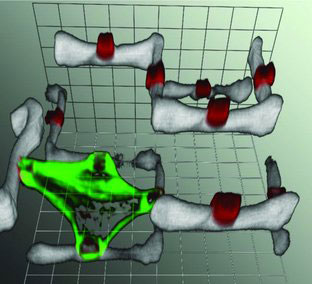| Mar 29, 2011 |
Growing cells on 3D scaffolds
|
|
(Nanowerk News) Researchers from the DGF-Centre for Functional Nanostructures (CFN) at the Karlsruhe Institute of Technology have succeeded in growing cells on three-dimensional structures ("Two-Component Polymer Scaffolds for Controlled Three-Dimensional Cell Culture").
|
|
What is so fascinating about this method is that the cells are able to attach to special micrometre-sized "handles" on the scaffolds and nowhere else. The direct laser writing method used gives the researchers led by Professor Martin Bastmeyer full control over the formation of cell adhesion sites and shape of the cells, which represents a major progress in the field of biomaterial engineering.
|
 |
| Controlled 3D Cell Culture in a polymer framework.
|
|
Numerous approaches for culturing cells in three-dimensional environments are available. The majority of these involve agarose, collagen fibres or matrigel to simulate the flexible three-dimensional in vivo environment of cells and make it possible to carry out experiments that mimic the complex in vivo arrangement of the extracellular matrix more realistically than two-dimensional Petri dishes. However, these substrates have the disadvantage that they are rather heterogeneous and have random-sized pores, which makes their structural and biochemical characterisation rather difficult.
|
|
The objective of Bastmeyer's team was to develop distinct three-dimensional cell culture substrates that only enabled the cells to adhere to particular sites of the scaffold. This method allows the researchers to systematically determine parameters such as cell shape, cell volume, intracellular force development or cellular differentiation in relation to the outer geometry of the cells' environment. These findings are suitable for use in the larger-scale production of three-dimensional growth environments for culturing cells required in regenerative medicine, for example.
|
|
The researchers achieved their goal by using a special polymer scaffold. The scaffold consists of a flexible, protein-repellent polymer with small cuboid-shaped handles consisting of a protein-binding material. The researchers produced the scaffold using direct laser writing, a method developed at the CFN by the physicists Professor Martin Wegener and Professor Dr. Georg von Freymann. Direct laser writing enabled the researchers to produce a protein-repellent structure that consists of small pillars (25µm) connected to each other with thin bars at different pillar height.
|
|
In a second lithography step, the researchers arranged the "handles" in the middle of the bars. When an adhesion protein solution is added, the proteins adhere selectively to these small handles. Individual cells then colonise the scaffold within a period of two hours, only adhering to the predetermined functionalised adhesion sites.
|
|
The CFN researchers from Karlsruhe have for the first time ever produced materials that can be used for the control of cell adhesion and cell shape in three dimensions. This represents an important step on the road towards understanding how the natural tissue environment affects the growth of cells.
|

